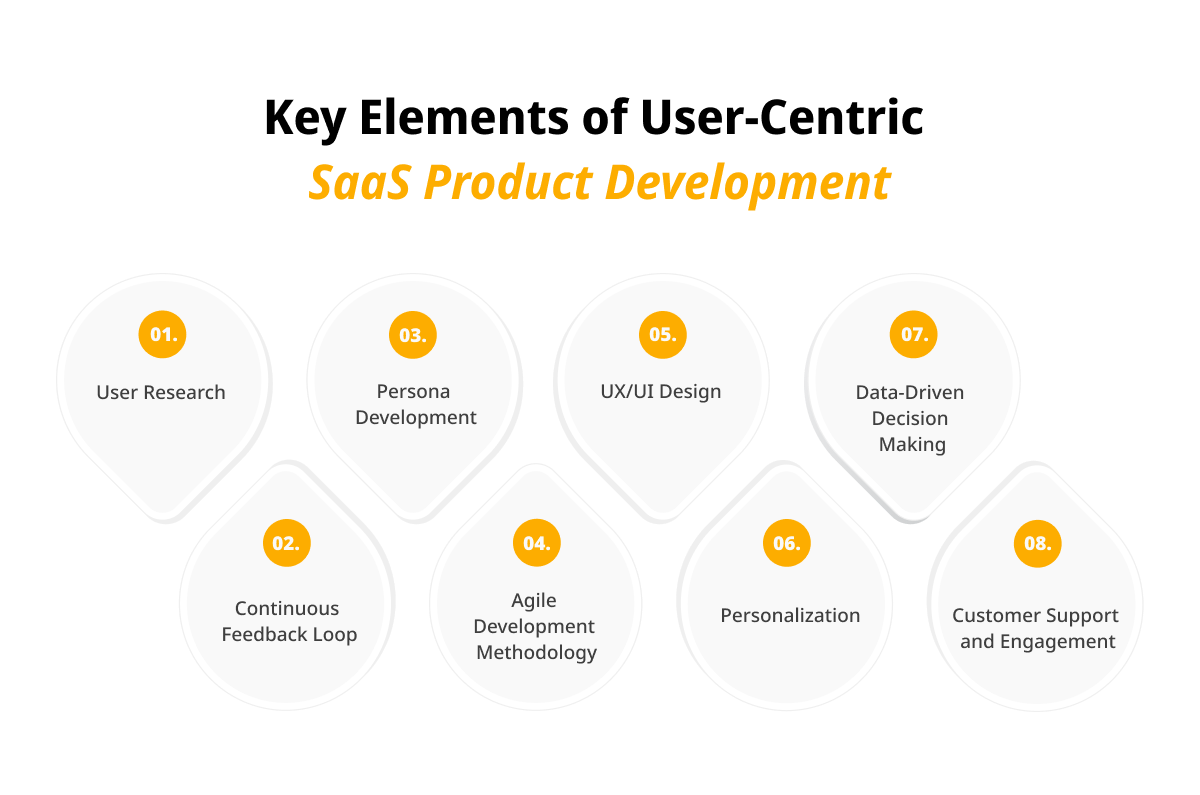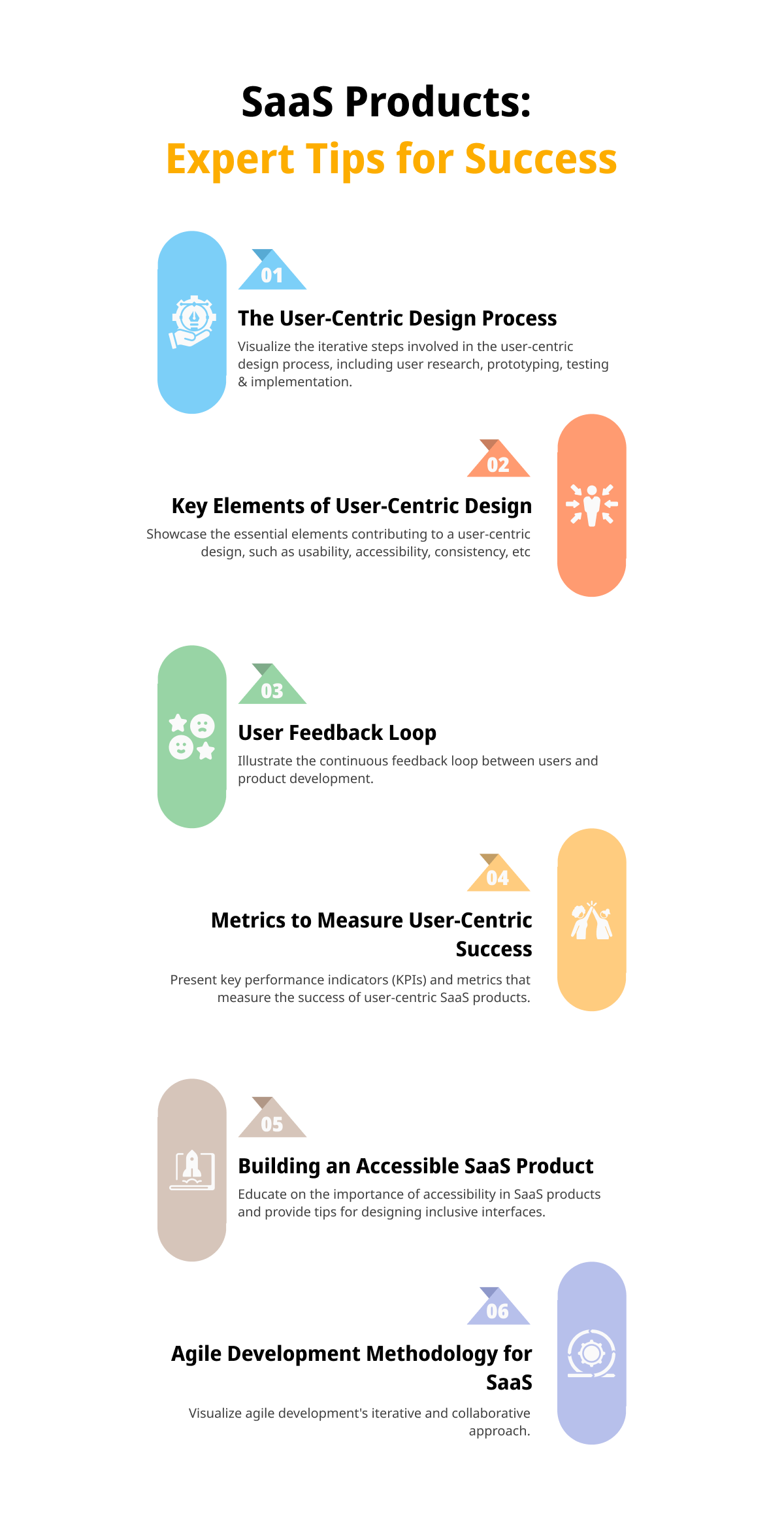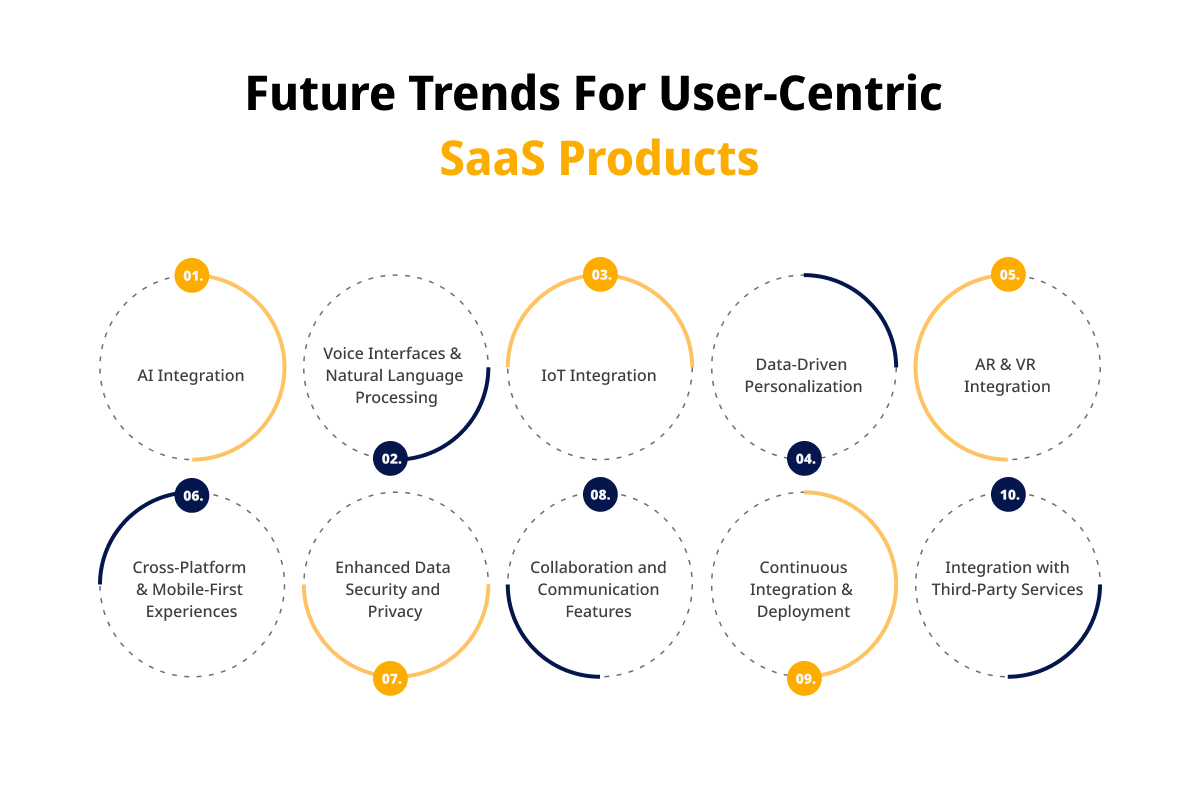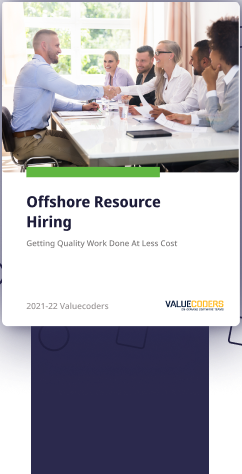The concept of SaaS began to gain prominence in the late 1990s and early 2000s when internet connectivity became more widespread and reliable. Saas offered a paradigm shift by providing software applications over the internet on a subscription basis.
And in no time, this model eliminated the need for users to manage complex software installations, updates, and hardware requirements.
Today creating a user-centric SaaS product requires more than just excellent coding skills – it takes a deep understanding of your target audience and their needs.
As per a report by Grand View Research, the SaaS (Software as a Service) market is growing rapidly, with a compound annual growth rate (CAGR) of 13.7% from 2023 to 2030. It means the competition will only become more challenging in the coming time, and you need to create a Saas product that stands out in the market.
To help our readers with SaaS product management and create unique products, we will share some expert tips on building user-centric SaaS products to create a happy clientele.
From conducting customer research to prioritizing features based on user feedback, we have everything you need to know to create a winning SaaS product that puts your customers first.
So get ready to learn from the best in the business!
Watch This Video For a Quick Overview:
Understanding User-Centricity in SaaS Products
First, you must understand why your business needs a user-centric approach and why it is paramount in SaaS product management & development.
This approach recognizes that users are the ultimate judges of a product’s success and aims to design experiences that delight and empower them.
Here is why you need to understand your target audience to ensure the success of your project:
- Increased User Satisfaction: By thoroughly understanding the needs, preferences, and pain points of the target audience, businesses can design and tailor the product to meet their specific requirements. This results in a solution that resonates with users, addressing their challenges and providing a seamless experience.
- Improved Customer Loyalty: When users feel that their needs are genuinely understood and addressed, they develop a sense of trust and affinity towards the product and the brand behind it. They appreciate the personalized attention given to their requirements and become more loyal to the product over time. This loyalty translates into long-term customer relationships, recurring revenue, and a more substantial customer base.
- Increased Revenue: By focusing on the user’s needs and pain points, SaaS products can provide solutions that genuinely improve the users’ operations, productivity, and efficiency.
When businesses experience tangible benefits by using a product, they are often willing to invest more in its continued usage or upgrade to higher-tier plans. This results in increased revenue for the SaaS provider, driven by user satisfaction and the perceived value delivered by the product.
Discover Expert Tips for User-Centric Product Development and SaaS Consulting Success
Balancing User Needs With Business Goals
While user-centricity is crucial, balancing user needs and business goals is also essential. SaaS products should align with the organization’s objectives while meeting the requirements and expectations of the target user base.
This requires considering market demand, competitive landscape, and revenue generation potential. By finding the right balance, businesses can create SaaS products that delight users and drive business growth and profitability.
Understanding user needs will help businesses find the right SaaS product development company to outsource their projects and receive desired results.
Key Elements of User-Centric SaaS Product Development
-
User Research & Persona Development
User research is a fundamental element of user-centric SaaS product development. It gathers insights into user behaviors, needs, and pain points through interviews, surveys, and analytics.
These insights help create user personas, and fictional representations of target users, which inform the design and development process. By understanding users’ goals, preferences, and challenges, SaaS products can effectively be tailored to meet their needs.
-
Intuitive User Interface (UI) and User Experience (UX) Design
A crucial aspect of user-centric SaaS products is designing intuitive UI and delivering exceptional UX. A well-designed UI focuses on simplicity, clarity, and ease of use. It involves creating straightforward navigation, consistent visual elements, and an organized layout that seamlessly guides users through the product.
UX design aims to provide a delightful and satisfying experience by ensuring smooth workflows, intuitive interactions, and responsive performance. You can outsource SaaS product development to ensure the best quality and meet your project goals.
-
Continuous User Feedback Loop
Whether you are working on SaaS product management or development, creating a feedback loop with users is vital. Regularly collecting and analyzing user feedback helps identify pain points, uncover areas for improvement, and gather insights on user satisfaction.
Feedback can be obtained through surveys, feedback forms, user testing sessions, or customer support interactions. But here’s a thought – phone systems for small businesses can be a part of your toolkit. It’s a surprisingly simple yet effective way to encourage your users to speak up, offering that personal touch that can make all the difference. By actively listening to user feedback, product teams can iterate on features, address usability issues, and enhance the overall user experience.
-
Personalization & Customization
SaaS products that prioritize personalization and customization offer users the ability to tailor the product to their unique preferences and requirements.
This could include customizable dashboards, flexible settings, or personalized recommendations based on user data.
By providing options for customization, SaaS products can adapt to individual user needs, enhance user engagement, and foster a sense of ownership and satisfaction.
-
Performance & Reliability
Performance and reliability are critical elements of user-centric SaaS products, and you should include them in your SaaS product management strategy. Users expect fast-loading times, smooth interactions, and reliable access to the product.
Optimizing performance involves efficient code, optimized database queries, and proper use of caching techniques. Reliability includes minimizing downtime, addressing bugs and issues promptly, and ensuring data security. Robust infrastructure and regular monitoring are essential to maintain high performance and reliability levels.
By incorporating these key elements into the development process, SaaS products can prioritize user needs, enhance user satisfaction, and build long-term customer loyalty. You can hire developers skilled in application development for SaaS companies if you need expertise.
Also Read: 20+ SaaS Product Ideas To Empower Your Business-Valuation
Strategies For User-Centric SaaS Product Development
Here are some valuable strategies to help you develop user-centric SaaS products that meet users’ expectations.
-
Agile & Iterative Development
Implementing agile methodologies is a strategy that promotes user-centricity in SaaS product development.
Agile allows for flexibility and collaboration, enabling teams to adapt to user feedback and changing requirements.
By breaking down the development process into iterative cycles, features and improvements can be delivered incrementally.
This approach allows for early user validation and ensures that the product evolves based on user needs and preferences.
-
Collaboration Between Designers, Developers, and Product Managers
Designers, developers, and product managers should work together closely throughout the development lifecycle. This cross-functional collaboration is essential for creating user-centric SaaS products.
By sharing insights, expertise, and perspectives, teams can ensure that user needs are addressed in design decisions & technical implementations.
Regular communication and collaboration foster a holistic approach to product development, resulting in better user experiences.
-
Usability Testing & User Validation
Usability testing enables real users to interact with the product and provide feedback on its usability, intuitiveness, and effectiveness. It involves users in the validation process, which is a crucial strategy for user-centric SaaS product development.
By analyzing user behaviors and gathering feedback, teams can identify usability issues, uncover areas for improvement, and validate design decisions. This iterative approach ensures that the product meets user expectations and delivers a satisfactory user experience.
-
Continuous User Feedback and Iterative Improvements
Creating a culture of continuous user feedback is very important for user-centric SaaS product development.
Encouraging users to provide feedback through various channels, such as feedback forms, surveys, and customer support, helps them understand their evolving needs and preferences.
This feedback should be analyzed, prioritized, and incorporated into product iterations. Regular releases and updates based on user feedback ensure the product remains relevant and aligned with user expectations.
-
Data-Driven Decision Making
Leveraging data to drive decision-making is an impactful user-centric SaaS product development strategy.
By collecting and analyzing user data, teams can gain insights into user behavior, usage patterns, and preferences. This data-driven approach helps identify trends, make informed design decisions, and prioritize product improvements.
By understanding user needs and preferences through data analysis, SaaS products can be tailored to deliver personalized experiences and meet user expectations.
By implementing these strategies, SaaS product development management & development teams can prioritize user needs, enhance user satisfaction, and create products that truly resonate with their target audience.
The combination of agile development, cross-functional collaboration, usability testing, continuous user feedback, and data-driven decision-making ensures that user-centricity remains at the core of the product development process.
Expert Strategies for User-Centric Product Development and Effective SaaS Consulting
Case Studies: Success Stories in User-Centric SaaS Product Development
Let’s have a look at some success stories of user-centric products,
- Case Study: Streamlining Workflow Efficiency with User-Centric Design
- Industry: Project Management
- Challenge: A project management SaaS company noticed a significant drop in user engagement and satisfaction. Users found the platform complex and needed help navigating various features, resulting in decreased productivity.
- Solution: The company adopted a user-centric approach to address these challenges. We conducted in-depth user research to understand pain points and user preferences. Based on the findings, we redesigned the user interface to simplify workflows and improve usability. We also implemented personalized onboarding tutorials and in-app guidance to help users understand and utilize the platform.
- Results: The user-centric design changes resulted in a remarkable improvement in user engagement and satisfaction. User feedback indicated a reduction in the learning curve and increased overall productivity. User retention rates increased, and positive word-of-mouth spread among users, leading to significant growth in customer acquisition.
Case Study: Enhancing Customer Experience with Data-Driven Personalization
- Industry: Customer Relationship Management (CRM)
- Challenge: A CRM SaaS provider wanted to differentiate itself in a highly competitive market. The client aimed to deliver a personalized customer experience but needed help understanding individual user needs and preferences.
- Solution: The company implemented a data-driven approach to capture user data and provide personalized experiences. They leveraged machine learning algorithms to analyze user behavior, including interactions, preferences, and usage patterns. The team also introduced personalized recommendations, customized dashboards, and intelligent automation features based on the insights gained.
- Results: The user-centric personalization efforts led to a significant improvement in customer satisfaction and loyalty. Users appreciated the tailored experiences and reported increased efficiency in managing customer relationships. The company witnessed a notable increase in user retention rates, customer referrals, and overall revenue growth.
Case Study: AI Platform As A Service With IoE Platform
- Industry: IoE Platform
- Challenge: Some key challenges involved real-time messaging, auto-logout on idle state, real-time Gantt charts, and generating the QR tasks.
- Solution: The team proposed innovative solutions to tackle all the challenges and implemented the best strategies to ensure they don’t interrupt the user experience.
- Results: ValueCoders team successfully resolved the critical challenges of the project and delivered two high-performance applications. Both applications were popular amongst enterprises, with 1 million downloads within a short period. The average rating was over 4.7/5 on trusted review platforms. It became one of the most popular IoE platforms for enterprises and delivered a seamless user experience with an engaging & interactive interface.
Also Read: A Comprehensive Guide On SAAS Application Development Challenges & Solutions
The Future of User-Centric SaaS Products
As technology continues to evolve, so does the future of user-centric SaaS products. Here are some key trends and innovations that shape the future of user-centricity in the SaaS industry:
- AI-Driven Personalization and Automation: Artificial Intelligence (AI) transforms how SaaS products deliver personalized experiences. AI algorithms can analyze vast amounts of user data to understand individual preferences and behaviors, allowing SaaS platforms to provide highly personalized recommendations, content, and workflows.
- Enhanced User Experience through Augmented and Virtual Reality: Augmented Reality (AR) and Virtual Reality (VR) technologies open new avenues for user-centric SaaS product experiences. Advanced technologies offer users a more engaging and realistic experience, enabling them to visualize and interact with SaaS products in novel ways.
- Data Privacy and Security: With growing concerns about data privacy and security, the future of user-centric SaaS products will prioritize robust security measures. SaaS providers will implement advanced encryption techniques, multi-factor authentication, and anonymization to protect user data. Transparency in data handling practices, compliance with privacy regulations, and user control over their data will become crucial elements of user-centricity.
- Human-Centered Design and Inclusive User Experiences: User-centricity will increasingly embrace human-centered design principles to create inclusive and accessible user experiences. SaaS products will strive to accommodate diverse user needs, including users with disabilities, by implementing accessible design practices. This includes providing an alternative text for images, keyboard accessibility, and compatibility with screen readers, among other considerations.
The future of user-centric SaaS products is steered by AI-driven personalization, augmented/virtual reality experiences, voice-activated interfaces, data privacy/security measures, and inclusive design practices.
By embracing these trends and innovations, SaaS providers can continue to deliver exceptional user experiences, anticipate user needs, and stay ahead in an increasingly competitive landscape. Prioritizing user-centricity will remain a key driver of success and customer satisfaction in the evolving SaaS industry.
Navigating the SaaS Landscape with Consulting Excellence & Expert Tips.
Parting Thoughts
With a focus on user experience and satisfaction, it’s no surprise that building user-centric SaaS products is one of the critical success factors. In this blog, we’ve gathered expert tips to help you build better products that people will love. This will ensure user satisfaction and an increased ROI that will bring you closer to your business goals.
From understanding what makes an incredible customer journey to testing your product with real users, these tips will help ensure your products are successful from start to finish. Thanks for reading!








